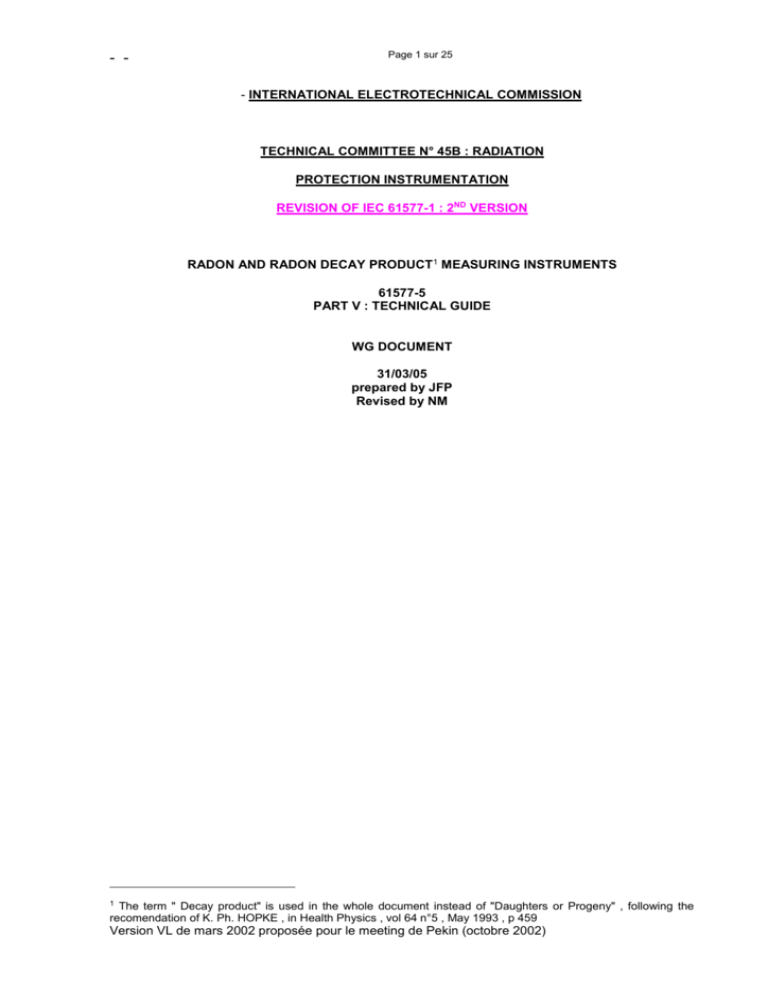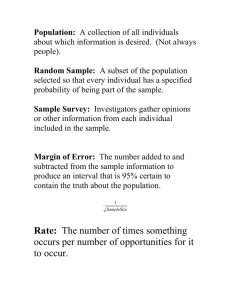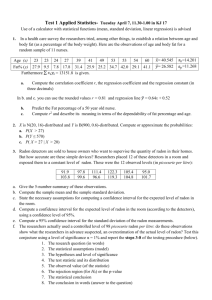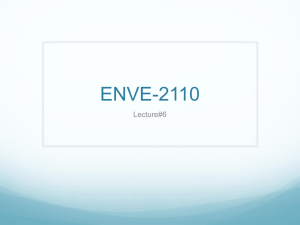3. Physical properties of radon and RnDP
advertisement

- - Page 1 sur 25 - INTERNATIONAL ELECTROTECHNICAL COMMISSION TECHNICAL COMMITTEE N° 45B : RADIATION PROTECTION INSTRUMENTATION REVISION OF IEC 61577-1 : 2ND VERSION RADON AND RADON DECAY PRODUCT 1 MEASURING INSTRUMENTS 61577-5 PART V : TECHNICAL GUIDE WG DOCUMENT 31/03/05 prepared by JFP Revised by NM 1 The term " Decay product" is used in the whole document instead of "Daughters or Progeny" , following the recomendation of K. Ph. HOPKE , in Health Physics , vol 64 n°5 , May 1993 , p 459 Version VL de mars 2002 proposée pour le meeting de Pekin (octobre 2002) - - Page 2 sur 25 1. Characteristics of the radioactive elements to be measured ..................................... 3 1.1 Radionuclides in the uranium and thorium series ...............................................................4 1.2 Heads of series ........................................................................................................................5 2. Physical and chemical properties of radon and RnDP ............................................... 8 2.1 Physical behaviour of radon ...................................................................................................8 2.2 Physical behaviour of decay products ..................................................................................8 3. Classification of radon and radon decay product measuring instruments ............. 12 3.1 Types of instrument used for measuring radon ................................................................ 12 3.2 Type of instruments used for measuring radon decay product ...................................... 13 4. Current used methods ................................................................................................ 13 4.1 Current used methods for measuring the activity of radon ............................................ 13 4.2 Current used methods for measuring RnDP and volume potential alpha energy ........ 14 4.3 Other standard methods used in RnDP measuring instruments .................................... 20 Version VL de mars 2002 proposée pour le meeting de Pekin (octobre 2002) Page 3 sur 25 - 1. Foreword : This document gives complementary informations concerning the most used radon and RnDP measuring methods. Some information regarding the physical properties of radon and RnDP are also provided. Quelques rappels sur les caractéristiques physico-chimiques des radioéléments à mesurer sont également présentés. 2. Characteristics of the radioactive elements to be measured Radon is a radioactive gas produced by the decay of 226Ra and 224Ra, respectively decay products of 238U and 232Th which are present in the crustal rocks .By decay, radon isotopes produces two decay chains ended by a stable lead isotope. 238U Figure 1 Uranium 238 and its decay products 234U 234Pa 234Th 230Th 226Ra 222Rn RnDP Long lived RnDP 218Po 214Po 214Bi 214Pb 232Th 210Bi 210Pb 206Pb Figure 2 Thorium232 and its decay products 228Th 228Ac 228Ra 210Po 224Ra 220Rn RnDP 216Po 212Po 212Bi 212Pb 208Pb 208Tl Version VL de mars 2002 proposée pour le meeting de Pekin (octobre 2002) Page 4 sur 25 - 2.1 Radionuclides in the uranium and thorium seriesi The radioactive characteristics2 of the nuclides in the following families or series are listed in tables 1 and 2 respectively: • uranium 238 (15 nuclides) Symbol Half-life Major radiation energies (MeV) alpha beta (average) gamma Number of atoms per Bq 2,03 1017 238 92 U 4,468109 y 234 90 Th 24,10 d Pa 1,17 min Pa 6,7 h 234 92 U 244 500 y 230 90 Th 77 000 y 226 88 Ra 1 600 y 222 86 Rn 3,8235 d 4,721 (27,4%) 4,773 (72,3%) 4,621 (23,4%) 4,688 (76,2%) 4,602 (5,55%) 4,785 (94,4%) 5,490 (99,9%) 218 84 Po 3,05 min 6,003 (100%) 214 82 Pb 26,8 min 214 83 Bi 19,9 min 214 84 Po 164,3 µs 210 82 Pb 22,3 y 0,016 13 (20%) 0,046 5 (4,05%) 1,01 109 Bi 5,012 d 0,388 9 (100%) 6,25 105 210 82 Po 138,38 d 206 82 Pb 234m 90 234 90 210 83 4,149 (22,9%) 4,198 (76,8%) 0,024 93 (18,6%) 0,050 55 (72,5%) 0,825 3 (98,3%) 0,063 29 (3,81%) 0,092 80 (2,69%) 3,00 106 1,01 102 0,141 0 (25,3%) 0,131 2 (19,7%) 0,141 2 (11,6%) 0,227 2 (5,50%) 0,198 1 (15,9%) 0,733 0 (8,58%) 34,70 103 1,11 1013 3,50 1012 0,186 (3,28%) 7,28 1010 4,77 105 2,64 102 0,207 2 (48,1%) 0,295 2 (19,2%) 0,227 4 (42,1%) 0,351 9 (37,1%) 0,491 9 (8,28%) 0,609 3 (46,1%) 0,525 2 (17,6%) 1,120 (15,0%) 0,539 3 (17,9%) 1,765 (15,9%) 1,269 (17,7%) 2,32 103 1,72 103 2,37 10-4 7,687 (100%) 5,297 (100%) 1,72 107 stable Table 1 - Uranium 238 nuclide radioactive characteristics • thorium 232 (12 nuclides) 2All the radioactive data given in this standard are extracted from : ICRP publication 38, Annals of ICRP, vol 11-13, 1983. Version VL de mars 2002 proposée pour le meeting de Pekin (octobre 2002) Page 5 sur 25 - - Table 2 - Thorium 232 nuclide radioactive characteristics Symbol Half life Major radiation energies (MeV) alpha 232 90 1,405101 228 88 Ra 5,75 y 228 89 Ac 6,13 h 228 90 Th 1,9131 y 224 88 Ra 3,66 d 220 86 Rn 55,6 Th 0,338 4 (12%) 0,911 1 (29%) 0,968 9 (17,5%) 31,8 103 87 106 456 103 s 6,779 (100%) 216 10-3 s 212 82 Pb 10,64 h 212 83 Bi 60,55 min 6,051 (25,2%) 6,090 (9,63%) 212 84 Po 0,305 µs 8,785 (100%) 3,07 min Pb 262 106 5,340 (26,7%) 5,423 (72,7%) 5,449 (4,9%) 5,686 (95,1%) 6,288 (99,9%) 0,15 208 82 Number of atoms per Bq 639 1015 0,009 865 (100%) 0,386 1 (40,4%) 0,610 8 (11,4%) Po Tl gamma 3,952 (23%) 4,010 (76,8%) 216 84 208 81 2.2 y 0 beta (average) 80,2 0,041 94 0,238 6 (44,6%) (5,21%) 0,094 46 (84,9%) 0,172 7 (9,89%) 0,190 5 (3,44%) 0,727 2 (11,8%) 0,228 6 (2,65%) 0,530 6 (7,9%) 0,831 5 (48,4%) 55,3 103 5,24 103 4,4 10-10 0,438 8 (22,8%) 0,510 8 (21,6%) 0,532 5 (22%) 0,583 1 (85,8%) 0,646 5 (50,9%) 0,860 4 (12%) 2,615 (99,8%) 266 stable Heads of series It is worth noting that the properties of the nuclides at the head of each series, as given in the tables, show that their half-lives are comparable with the age of the earth: • age of the earth: 5 × 109 years • half-life of uranium 238: 4,468.109 years • half-life of thorium 232: 1,405.1010 years Thus, the proportions of these radionuclides that still persist on the earth, expressed in terms of the number that existed at the time when the earth was formed, are: • 46 % for uranium 238; • 78 % for thorium 232. Version VL de mars 2002 proposée pour le meeting de Pekin (octobre 2002) - - Page 6 sur 25 Note - By convention , the uncertainty of the value of the half-life and of the energies of emissions of the measured radionuclides will be taken as zero .The values of these conventionally true values are given in tables 1 and 2. Version VL de mars 2002 proposée pour le meeting de Pekin (octobre 2002) - - Page 7 sur 25 Version VL de mars 2002 proposée pour le meeting de Pekin (octobre 2002) Page 8 sur 25 - 3. Physical properties of radon and RnDP A description of the physical and chemical characteristics of radon and RnDP is given in the table 3 . This draws the attention to the fact that, in spite of the small number of atoms present in such an atmosphere, phenomena of a chemical and/or physical nature can sometimes cause changes in the overall characteristics of the atmosphere under investigation iiiiiiv. Table 3v- Physical characteristics of the main components of a reference atmosphere 3.1 Specific gravity kg m-3 Melting point °C Boiling point °C Radon (222Rn, 220Rn) 9,73 -71 °C - 61,7 °C Polonium (218Po, 214Po, 216Po, 212Po, 210Po) 9 320 254 °C 962 °C Bismuth (214Bi, 212Bi, 210Bi) 9 747 271,4 °C 1 564 °C Lead (214Pb, 212Pb, 210Pb) 11 350 327,46 °C 1 749 °C Thallium (208Tl) 11 850 304 °C 1 473 °C Physical behaviour of radon One must be aware of the fact that 100 Bq.m -3 of radon in a gaseous form represent only few 10-15 mm3. In the domain of radon measurement, the elements to be mesured are present only as trace quantities . 3.2 Physical behaviour of decay products The decay products of radon consist mostly of isotopes of Pb, Bi, Tl and Po, all solids at ambient temperature. They therefore are present in the atmosphere under investigation in the form of aerosols which can be classified into two groups: Unattached fraction : when radon decays, the atoms of frehsly formed polonium may quickly attach to airborne particles. Those atoms that remain unattached will rapidely ( in a period of time of few seconds) group to form clusters . Attached fraction : radioactive atoms or clusters of atoms attached to airborne particles . 3.2.1 Characteristic parameters of an aerosol An aerosol is characterised by certain parameters, the most significant of which is the diameter of its constituents. This can be measured using an optical or electron microscope. Generally speaking, the real diameter is replaced by the median equivalent aerodynamic and/or thermodynamic diameter. The diameters that concern us range from some 10 -10 m (unattached fraction) to several 10-5 m. Version VL de mars 2002 proposée pour le meeting de Pekin (octobre 2002) Page 9 sur 25 - An aerosol may be: either monodisperse, when all the constituent particles have the same size; or polydisperse, when the particle size distribution extends over a certain range of diameters. For ultrafine aerosols and the free fraction, a second important parameter is the coefficient of diffusion 2 -1 (denoted by D and expressed in m s ). This reflects the ability of an ultrafine aerosol to become attached through Brownian diffusion to any particle or surface. A third important parameter is the electric charge on the aerosol due to the removal of outer electrons, either by electrical or mechanical action, or during the decay of the parent radionuclide. Other parameters such as mass and chemical type may be relevant (for example, in the determination of the collection efficiency of sampling devices), but their effect is generally significant only for particles with diameters greater than several µm. 3.2.2 Behaviour of an aerosol The particles making up an aerosol are subjected to the following forces: - turbulent diffusion; - Brownian diffusion; - inertia, which may causes a deflection of the path in the carrier fluid followed by an impact on any surface present; - gravity, which produces sedimentation; - electrostatic forces; - drag forces due to the viscosity of the carrier fluid. - These forces act in different ways depending on the particle size distribution of the aerosol and its velocity . 3.2.3 Particle size distribution of radioactive aerosols The spectrum of sizes exhibited by radioactive aerosols is the result of the diffusion of the ultrafine radioactive particles on to atmospheric condensation nuclei. The disappearance of the ultrafine particles through their attachment to larger particles is governed by the law: where n is the concentration of ultrafine particles; N is the concentration of condensation nuclei; is the attachment coefficient. In a first approximation, it is possible to calculate the theoretical spectrum of radioactive nuclei from the above formula and from the theoretical or experimental spectrum of the condensation nuclei. Version VL de mars 2002 proposée pour le meeting de Pekin (octobre 2002) Page 10 sur 25 - - As an example, the diagram set out in figure A.1 is typical of the atmosphere in an underground minevi. Figure 1 - Particle size distribution typical of the atmosphere in an underground mine Particle size distribution 1400 Particles / cm3 1260 1120 980 840 700 560 420 280 140 0 0,001 0,01 0,1 Particle radius ( µm Condensation Nuclei ) 1 Attached RnDP 3.2.4 Potential alpha energy as a health risk indicator vii The concept of potential alpha energy (PAE) originates in the field of health physics and is a risk indicator used in connection with the radiological protection of people exposed to radon and its decay products. Because it is a noble gas, radon does not remain in the lungs (the target organ) and hence is not normally involved in the PAE concept. It is the short-lived solid decay products which present a potential risk to health, since they occur in the atmosphere in the form of aerosols and may therefore be deposited in the respiratory tract where they release their energy by causing damage to cells. If the radioactive series (tables A.1 and A.2 ) are examined, it can be seen that 214 Po and 212Po, for example, because of their very short half-life , are virtually non-existent in the atmosphere , decaying as soon as they are formed. Everything occurs as if the alpha particles they emit were emitted by their predecessors, in this case 214Bi and 212Bi. In the 222Rn series , 218Po emits alpha particles with an energy of 6,003 MeV. However owing to the very short radioactive half-life of its decay products compared with the time taken for biological elimination , 214Pb and then 214Bi will be formed at the spot where 218Po was deposited and will then decay there, ending up with the emission of an alpha particle from 214Po with an energy of 7,687 MeV. Everything occurs as if the 218Po had emitted two alpha particles in all, with energies of 6,003 MeV and 7,687 MeV respectively. The total energy which will then have been yielded up to lung tissue will amount to 6,003 +7,687 = 13,690 MeV. Version VL de mars 2002 proposée pour le meeting de Pekin (octobre 2002) Page 11 sur 25 - - By definition, this is the potential alpha energy of a Calculation of the potential alpha energy of 214Bi 218Po atom. and 214Pb gives 7,687 MeV. In the 220Rn series, the decay of 212Bi by alpha emission involves only 35,89 % of the total disintegrations, so that its potential alpha energy per atom is: 6,051 35,89 8,785 64,11 7,804MeV per atom. 100 100 212Pb, the beta-emitting predecessor of 212,Bi, will therefore also have a potential alpha energy of 7,804 MeV. It can be seen from this that, in order to deduce the total potential alpha energy of any mixture of radionuclides, we need to know only the number of atoms of each radionuclide involved in the mixture. Version VL de mars 2002 proposée pour le meeting de Pekin (octobre 2002) Page 12 sur 25 - 4. 4.1 Classification of radon and radon decay product measuring instruments Types of instrument used for measuring radon Caractéristique du prélèvement Méthode de détection Exemple applications Scintillation (ZnS, Ag) Fiole de Lucas ou fiole scintillante I, U,S Comptage alpha Détecteur silicium en regard d'un volume déterminé I,U,S Spectrométrie gamma Prélèvement dans un conteneur normalisé, alvéolé** Courant d’ionisation Chambre d'ionisation à circulation Compteur proportionnel Chambre d'ionisation à diffusion Spectrométrie alpha Détecteur silicium en regard d'un volume déterminé Détecteur solide de traces nucléaires "Dosimètre passif" Thermoluminescence Piégeage sur charbon actif Spectrométrie Par détecteur silicium Piégeage sur charbon actif Chambre d'ionisation à électrets Ponctuel Continu Intégré Décharge d’une surface polarisée Table 3 : Type of instruments used for measuring radon Version VL de mars 2002 proposée pour le meeting de Pekin (octobre 2002) Page 13 sur 25 - 4.2 Type of instruments used for measuring radon decay product Caractéristique du prélèvement Méthode de détection Exemple Ponctuel Scintillation (ZnS, Ag) Prélèvement sur filtre puis comptage avec un scintillateur: méthodes de Thomas* [9], Rolle* [10] Comptage Alpha Prélèvement sur filtre puis comptage avec un détecteur silicium: méthodes de Thomas* [9], Rolle* [10] Continu Prélèvement sur filtre et comptage simultané avec un détecteur silicium Intégré Prélèvement sur filtre "Dosimètre actif de site": Spectrométrie alpha mécanique Table 4- Type of instruments used for measuring radon decay product 5. Current used methods 5.1 Current used methods for measuring the activity of radon The methods described here are the most commonly used . Many other different methods exists which are mentioned in the tables 4 . Most instruments using these methods are now completely automated, and the corresponding informations are given only as reference purposes . 5.1.1 Measurement using an ionization chamber The use of an ionization chamber to measure radon was the first method adopted by Marie Curie viii. Its basic principles are as follows: An electrode is placed inside a conducting vessel containing the atmosphere to be analyzed and is maintained at a voltage different from that of the walls of the vessel. The absorption of the energy of the particles from the radon in the atmosphere contained in the vessel leads to the ionization of the gas and the electrons and ions formed, under the action of the potential difference, are collected by the electrodes . This creates pulses of charge or, if the number of particles emitted is high enough, an ionization current. The pulses of charge can be measured with a charge preamplifier or a charge measuring instrument. The ionization currents, which are very small ( 10-16 A), can be measured with electrometers. Even if the air is filtered before entering the ionization chamber, RnDPs are formed in the measurement volume, they become attached to the walls by diffusion, thus creating ionization not directly related to the radon being measured. This is reflected by an increase in background noise, leading to a rise in the threshold of detection by the device. As a result, systematic decontamination of the device is necessary, either by regular purging using a gas without radon, or by dismantling and cleaning. Ionization chambers operating in the pulse mode may, if equipped with a spectroscopic analysis of the pulses enabling the measurement of the alpha particles of the radon isotopes, be considered as Version VL de mars 2002 proposée pour le meeting de Pekin (octobre 2002) Page 14 sur 25 - - instruments allowing a direct method of measurement . As a result, this method can be used as a reference method for a STAR. 5.1.2 Measurement using scintillation devices The first instruments using the scintillation of ZnS(Ag) to measure radon were described by Lucas ix and Pradelx. They generally consist of an enclosed volume of a few hundred cubic centimeters which can be put into communication with the atmosphere under test. The interior of this volume is lined up with ZnS(Ag). For the analysis, the volume is optically coupled to the entrance window of a photomultiplier capable of detecting the photons emitted by the ZnS(Ag) when it is excited by the -particles from the radon and its decay products present in the volume. The photomultiplier is connected to a scaler counter which counts the total number of photons emitted. A simple formula relates the number of photons counted to the number of particles emitted and hence to the activity of the radon. Apart from their cheapness and the ease with which they can be used, such devices have a very high inherent sensitivity due to the relatively large area of detection. On the other hand, the direct contact that exists between the detector and the radon leads to increasing pollution of the instrument by the long-lived RnDPs formed in the interior, which become attached to the ZnS(Ag) by diffusion. The background noise of these devices thus inevitably increases as time goes on. 5.2 Current used methods for measuring RnDP and volume potential alpha energy The methods described here are some of the most commonly used for laboratory measurement purposes. They all are based on the collection of airborne radionuclides onto a filter, followed by mathematical analysis of the decay of the collected RnDP. Other different methods exists which are mentioned in the table 5. These other methods aren’t normally considered as reference method to be used in a STAR, but are given by IEC 61577-3, as methods used by the instruments under test . Some mathematical analysis concerning these other methods are described also in the clause D.3 . All these methods are primarily designed for the assessment of RnDP222 .Due to the relative long halflife of the 212Pb, the measurement of RnDP220 is not so easy; only few methods are able to provide this information ; they are cited along in the text . Most instruments using these methods are now completely automated, and the corresponding calculations are given hereafter only as reference purposes . 5.2.1 Thomas's methodxi (RnDP222) Thomas’s method allows determination of corresponding potential alpha energy. 218Po, 214Pb, 214Bi volume activities and calculation of the Successive decay of the three radionuclides follows exponential laws depending on the initial quantity of each of the elements. The corresponding equations were described by Batemanxii, optimized by Tsivoglouxiii and subsequently optimized by Thomas, leading to Thomas's formulation given below. The method involves three successive counts of a filter which has sampled the RnDPs at different time intervals. The time diagram is as follows for a 300 s sampling period : Table 6 : Time diagram, Thomas’s method Version VL de mars 2002 proposée pour le meeting de Pekin (octobre 2002) Page 15 sur 25 - Sampling Waiting First count Waiting I1 300 s 120 s 180 s Second count Waiting I2 60 s 840 s Third count I3 60 s Version VL de mars 2002 proposée pour le meeting de Pekin (octobre 2002) 540 s Page 16 sur 25 - g Let be the geometrical detection efficiency (4 sr); NPo218 be the number of 218Po atoms collected onto the filter ; NPb214 be the number of 214Pb atoms collected onto the filter; NBi214 be the number of 214Bi atoms collected onto the filter. We have: NPo218 = (1/g)(61,06 I1 - 29,64 I2 + 28,02 I3) NPb214 = (1/g)(0,43 I1 - 7,45 I2 + 17,7 I3) NBi214 = (1/g)(-8,13 I1 + 12 I2 - 13,63 I3) and PAE = (13,690 NPo218 + 7,687 (NPb214 + NBi214)) × 1,602×10 -13 (J) If the volume of air sampled is V (m 3), we obtain the potential alpha energy as PAEC = PAE V -3 (J m ). Thomas's method also enables the volume activities of the different nuclides to be determined. 5.2.2 Thomas's method optimized by Hartleyxiv (RnDP222) This method is the most recent optimization of the Thomas’s method and is identical to the previous one, except for the time diagram and the coefficients in the equations. The following time diagram (Table D.3) is optimized (in the sense of a maximum reduction in uncertainties) for else each RnDP or for PAE and depend upon the value of the equilibrium factor F .The following table D.2 presents an example of this time diagram. Table 7 : Optimal counting times of Thomas’s method optimised by Hartley Equilibrium factor F 0,5 Counting Time (s) Optimization of Po218 analysis Optimization of Pb214 analysis Optimization of Bi214 analysis Optimization of PAE analysis t1 270 240 240 240 t2 1830 1530 1530 1530 t3 3000 3000 3000 3000 The sampling time and the first waiting time are fixed, for example, to 300 s and 60 s, respectively, and there is no waiting time between the different counting times . The time schedule then becomes : Table 8 : Time diagram, Thomas’s method optimized by Hartley Version VL de mars 2002 proposée pour le meeting de Pekin (octobre 2002) Page 17 sur 25 - Sampling Waiting First count Second count Third count 300 s 60 s t1 t2 t3 I1 I2 I3 t1 , t2 , t3 start together after the waiting time . The equations then become: NPo218 = (1/g)(AI1 +BI2 + CI3) NPb214 = (1/g)(DI1 +EI2 +FI3) NBi214 = (1/g)(GI1 + HI2 +JI3) with I1,I2, I3 being the results of the counts respectively for counting time t1, t2, t3 , and with the coefficients A , B , C ... given as an example in the following table D.4 . Table 9 : Coefficient of Thomas’s method optimized by Hartley Equilibrium Factor F 0,5 Coeficient A B C D E F G H J Optimization of Po218 0,108 03 - 0,045 9 0,045 3 Optimization of Pb214 0,121 45 - 0,047 0,029 6 Optimization of Bi214 0,121 45 - 0,047 0,029 6 Optimization of PAE 0,121 45 - 0,047 0,029 6 - 9,13910-3 - 2,60510-3 0,015 7 - 8,64710-3 - 4,121 310-3 0,012 88 - 8,64710-3 - 4,121 310-3 0,012 88 - 8,64710-3 - 4,121 310-3 0,012 88 - 6,49010-3 0,015 1 - 0,018 0 - 9,34510-3 0,017 15 - 0,012 6 9,34510-3 0,017 15 - 0,012 6 9,34510-3 0,017 15 - 0,012 6 A combination of , , and measurements will give the best independant evaluation of each radionuclide and then the most reliable evaluation of RnDP volume activity. This is e.g. described by B.M. Hartleyxv. Version VL de mars 2002 proposée pour le meeting de Pekin (octobre 2002) Page 18 sur 25 - Markov's methodxvi (RnDP222) 5.2.3 Markov described a rapid method for the estimation of the volume activity of Its time schedule is as follow : 218Po and of the PAEC . Table 10 : Time diagram, Markov’s method Sampling Waiting First count Waiting Second count I1 300 s 60 s 180 s I2 180 s 180 s Assuming that : I1 being the result of the first counting period ; I2 being the result of the second counting period ; being the counting efficiency ; being a self-absorption correction coefficient for alpha particles ; (m3.min-1) . Q being the sampling flow rate . The 218Po volume activity is given by : Av 218 1,18.(I1 I 2 ) .0,037 , ..Q (Bq.m-3) The PAEC is then given by : PAEC 40.I 2 .1,602.10 7 ..Q (µJ.m-3) The resulting overall uncertainty is in the order of 15 % . 5.2.4 Nazaroff's methodxvii (RnDP222 and RnDP220) This method uses alpha spectroscopy to determine the concentration of the short-lived decay products of 222Rn and 220Rn . The decay products are collected on a membrane filter . The activity is measured with a high resolution silicon solid state detector. Counting can take place under a partial vacuum (100 hPa) to give better energy resolution while minimising the contamination of the detector by recoil decay products . To separate the contributions from the decay products, including those from 220Rn, three energy intervals and two counting periods are used : 1) 1,0 - 6,15 MeV (218Po, 212Bi) 2) 6,15 - 8 MeV (214Po) 3) 8,0 - 9,8 MeV (212Po). Version VL de mars 2002 proposée pour le meeting de Pekin (octobre 2002) Page 19 sur 25 - - The 220Rn decay chain branches, give 35,891 % of counts in the energy range 1) and 64,110 % in the energy range 3) . This allows the contribution from 212Bi in energy range 1) to be estimated and substracted . Some counts from 214Po will occur in energy range 1); the observed counts can be corrected after decay of the 218Po . The time diagram for sampling and counting is : Table 11 : Time diagram, Nazaroff’s method Sampling 5 min Waiting 1 min First count 10 min Waiting 10 min Second count 19 min The following is assumed: (m3), V is the total volume sampled is the detection efficiency . After correction for peaks overlap between the two first energy intervals concerning respectively the 218Po and the 214Po (if needed), the counts in the two first energy intervals are corrected for contributions from RnDP220 , calculated from the energy interval 3) . The following raw results are obtained : C218Po (1) corrected counts in energy interval 218Po in the first counting period ; C218Po (2) corrected counts in energy interval 218Po in the second counting period ; C214Po (1) corrected counts in energy interval 214Po in the first counting period ; C214Po (2) corrected counts in energy interval 214Po in the second counting period ; C212Po (1) counts in energy interval 212Po in the first counting period ; C212Po (2) counts in energy interval 212Po in the second counting period ; The volume activities of the RnDP222 APo218 , APb214 , ABi214 are : A Po218 1,7257 C 218Po (1) V (Bq.m-3) A Pb214 0,5418 C 214Po (2) 0,4406 C 214Po (1) 0,1251 A Po218 V (Bq.m-3) A Bi214 0,4466 C 214Po (1) 0,0210 A Po218 0,2992 A Pb214 V (Bq.m-3) . The equivalent equilibrium volume activity or the volume potential alpha energy can then be expressed as follow : EECRn 0,1065 APo218 0,5150 APb214 0,3786 ABi214 (Bq.m-3) PAEC 0,579 A Po218 2,86 A Pb214 2,1 A Bi214 109 (J.m-3) Version VL de mars 2002 proposée pour le meeting de Pekin (octobre 2002) Page 20 sur 25 - - For RnDP220, the following results are obtained: A Po212 1,7257 C 212Po (2) V (Bq.m-3) This method has been chosen in principle as a reference method by the National Radiological Protection Board (N.R.P.B.) (UK) . 5.3 Other standard methods used in RnDP measuring instruments 5.3.1 Hill'sxviii method This is the first method to have given rise to a portable independently operating instrument for measuring PAEC . The method is based on the fact that, at constant PAEC , the sum of the and ß emissions from the RnDPs deposited on a filter is almost constant. It has also the advantage to give a good estimate of the age of the air and of the equilibrium factor in the range 0,1 < F < 0,7 . The instrument designed to exploit this method used the following sequence: Table 12 : Time diagram, Hill’s method Sampling & Background counting Waiting and ß counting 2 min 0,5 min 2 min The background noise is measured during the sampling . It can be read off at the end of the sampling and subtracted automatically. The result is given in WL. With its pump, the instrument forms a compact unit and is fairly practical. The result is obtained quickly, enabling the sampling to be restarted in case of doubt. However, the presence of the counter using a plastic scintillator makes the instrument very sensitive to the ambient gamma field. When the level of this field becomes significant in comparison with the levels of and ß activity, considerable errors of measurement may occur, particularly if there are variations in the gamma field during the measurement (movement of staff or machines, change in the orientation of the instrument during the measurement, etc). 5.3.2 5.3.2.1 Kusnetz'sxix method (RnDP222 and RnDP220) Measurement of RnDP222 This uses a single gross alpha count to estimate the potential alpha energy. The sequence for the analysis of RnDP222 is as follows: Table 13 : Time diagram, Kuznetz’s method Let Sampling Waiting 5 to 10 min 40 to 90 min Counting N1 be the number of counts per minute, corrected from background, at counting time t1; g be the geometrical counting efficiency (4 sr); V be the volume sampled (liters); Version VL de mars 2002 proposée pour le meeting de Pekin (octobre 2002) Page 21 sur 25 - K be the correction factor. We have: PAEC222 = 20,8. N1 g .V.K (µJ.m-3) K can be calculated from the following expressions : K= 230 - 2.t1 for 40 min t1 70 min K= 195 - 1,5.t1 for 70 min t1 90 min The main interest of the method is that it enables the analysis to be made by alpha counting in the laboratory, which is an advantage given the long waiting time. However, because of this rather long waiting time, it does not give immediate information about the state of the atmosphere under investigation. 5.3.2.2 Case of a mixture of RnDP222 and RnDP220 In the presence of RnDP220, a modified equation apply : 20,8.(N1 N2.ePb212 ) PAEC222 = g .V.K .t (µJ.m-3) with : N2 be the number of counts per minute, corrected from background, at counting time t2; Pb212 be the decay constant for 212Pb and ; t = t2 - t1 . 5.3.2.3 Measurement of RnDP220 The potential alpha energy of RnDP220 can be calculated as follows : PAEC220 = 20,8. N g .V.G (µJ m-3) N be the number of counts per minute, corrected from background, at counting time t; G can be calculated from the following expressions : 5.3.3 G 13 - 0,7675.(t - 5) for 5ht9h G= 11,64 - 0,5159.(t - 5) for 11 h t 17 h Rolle'sxx method (RnDP222) Rolle has described a method based on a global alpha count at a fixed instant of time after the end of sampling. Various combinations of sampling and measuring times are proposed. Version VL de mars 2002 proposée pour le meeting de Pekin (octobre 2002) Page 22 sur 25 - - An estimate of the PAEC is obtained directly by applying a simple coefficient to the count. This is the method chosen in designing some instruments. The sequence chosen is as follows: Table 14 : Example of time diagram, Rolle’s method Sampling and Background count Waiting Counting 2 min 8 min 2 min -3 Subtraction of any contamination is automatic and the result is given directly in µJ m , the sampling rate being calculated by the incorporated electronic flow-meter. The counting is carried out using a silicon detector insensitive to gamma radiation. Automatic display of the level of contamination at the end of the sampling makes it possible to detect any contamination of the instrument that might have occurred. The result is obtained 10 minutes after the end of sampling and again allows the sampling to be taken or renewed in doubtful cases. Version VL de mars 2002 proposée pour le meeting de Pekin (octobre 2002) Page 23 sur 25 - - For the sequence used in some instruments, Rolle gives the following relationship in his description of the method: 1 nJ (PAE) on the filter corresponds to 10 dpm on the filter (4 sr). Let Q be the sampling rate -1 (l min ); TP be the sampling time (min); Tc be the counting time (min); d be the detection efficiency (4 sr); L be the displayed value of the potential alpha energy (µJ m ); -3 N0 be the number of alpha particles corresponding to the contamination counted during the time TP; N be the number of alpha particles counted during the counting time T c; A(t) be the radioactivity of the decay products collected on the filter (Bq). Then we have: A(t) = N 60.Tc . d (Bq) or, with TP = Tc = 2 min and the deduction of the contamination: L= 60.A(t) 1 . 10 Q.TP (µJ m ) L= N N0 40.Q. d (µJ m ) Version VL de mars 2002 proposée pour le meeting de Pekin (octobre 2002) -3 -3 Page 24 sur 25 - - iRadionuclide transformations, Energy and Intensity of Emissions, , ICRP publication 38, Annals of ICRP, Vol. 11-13, 1983, Pergamon Press ii JUNGE, C., Air Chemistry and Radioactivity, Academic Press, New York, London, 1963. iiiSTEIN, L. , Chemical Properties of Radon in Radon and its Decay product, Chap 18, HOPKE, Ph.K. American Chemical Society, Washington 1987 ivSTEIN, vCRC L. , The Chemistry of Radon , Radiochim. Acta 32 : pp163-171 (1983) Handbook of Chemistry and Physics, 74th edition, CRC Press, 1993-1994 viDUPORT, Ph. L'aérage et les caractéristiques de l'atmosphère d'une mine d'uranium laboratoire; Application à la répartition des particules radioactives dans les voies respiratoires, Thèse de Doctorat Faculté des Sciences de Brest 1976 viiLimits for Inhalation of Radon Daughters by Workers, Publication N° 32, Annals of the ICRP, Vol. 6 ,N°1 , 1981, Pergamon Press . viiiCURIE, M. , in RADIOACTIVITE, Hermann & Cie , Paris, 1935. ixLUCAS, H.F. , Improved Low Level Alpha Scintillation Counter for Radon, Rev. Sci. Instrum., 28 : 680, 1957 xPRADEL, J. , Dosage du Radon par Scintillation, in CEA Bull. Inf. Scient. et Techn. 1956, 2, 12 xi THOMAS, J. W., Measurement of radon daughters in air, Health Physics, , Vol.. 23, (Dec 1972), pp 783-789. xiiBATEMAN, H. , Solution of Differential Equations Occuring in the Theory of Radioactive Transformations .Proc. Cambridge Phil. Soc. 15:432; 1910 xiii TSIVOGLOU, E. C., AYER, H. E. HOLADAY, D. A., Occurrence of non-equilibrium atmospheric mixtures of radon and its daughters, Nucleonics, 11, no 9, p 40, 1953. xiv HARTLEY, B. M. , An analysis of statistical uncertainties which arise in Thomas's method of determination of the concentrations of the descendants of radon, Radiation Prot. in Australia, 1989, Vol. 7, no 1, 3 - 7. xv HARTLEY, B. M., A new method for the determination of the activity of short half-life descendants of radon, J. Radiol. Prot., 1989, vol. 9, no 3, pp 165-177. HARTLEY, B.M., A theoretical study of optimal methods for the determination of the activities of the descendants of radon, Radiol. Prot. in Australia, 1990, vol. 8, N°2, pp 38-40. xviMARKOV , STAS , RYABOV (1962), A rapid method for estimating the hazard associated with the presence of radon and radon daughters in air , Atomnaia Energia, , vol. 12, N° 4, pp 315-319 , April 27 , 1961 . xvii NAZAROFF, W. W. , NERO, A. V. REVZAN, K. L., Alpha spectrometric techniques for field measurement of radon daughters, Natural Radiation Environment, Editors KG Vohra, UC Mishra, KC Pillai and S Sadisvan, pp 350-357, Wiley eastern Ltd. New Dehli (1982). Version VL de mars 2002 proposée pour le meeting de Pekin (octobre 2002) - - Page 25 sur 25 xviiiMILLER, R.W., DENEBERG, B., MOORE, G., A new monitoring technique for airborne radon daughters, Proceeding of the 9th Midyear Topical Symposium of the Health Physics Society, February 9-12, 1976 , MILLER, R.W.,CLEVELAND, J., KUMP, D., An instant working level meter, Proceeding of the American Industrial Hygiene Conference, May, 1976 . xixKUSNETZ, H. L., Radon daughters in mine atmosphere, American Industrial Hygiene Association Journal Quarterly, Vol. 17,N°1,pp. 85-88, March 1956 . xxROLLE, R., Rapid working level monitoring, Health Physics, Vol. 22(March), pp. 233-238, Pergamon Press, 1972 , ROLLE, R., Improved radon daughters monitoring procedure, , American Industrial Hygiene Association Journal, pp. 153-160, March-April 1969 . Version VL de mars 2002 proposée pour le meeting de Pekin (octobre 2002)








